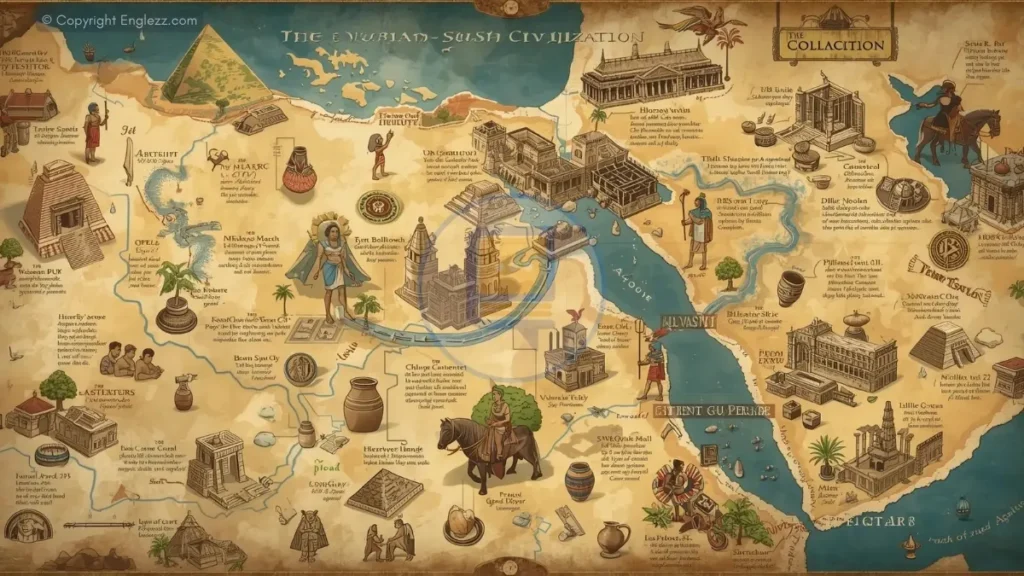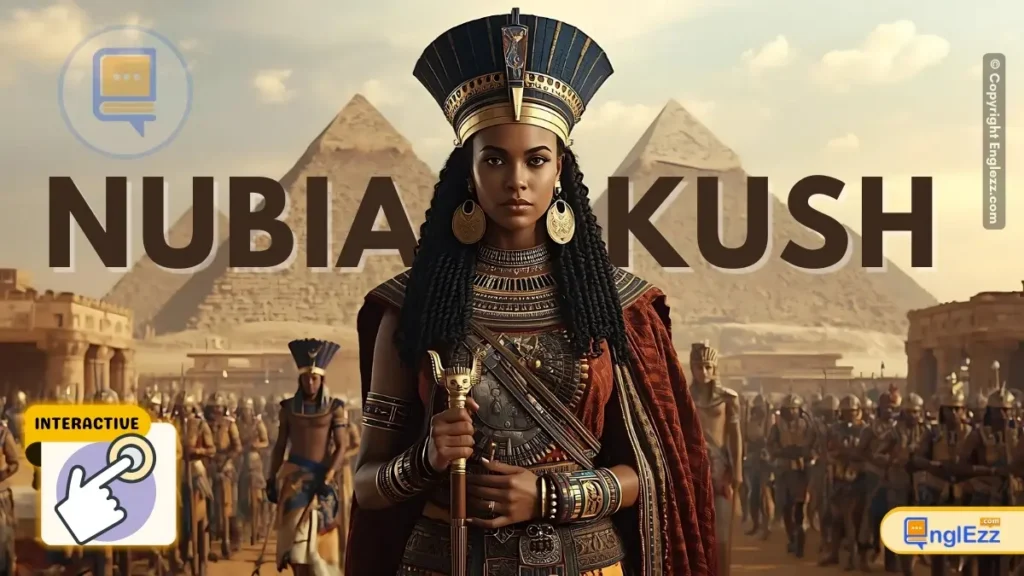
The Kingdom of Nubia Kush Civilization
Ancient Rivals of Egypt & Builders of Meroë Pyramids (2500 BCE-350 CE) –
Introduction
The Nubian Legacy
The Kingdom of Kush (also called Nubia) was a powerful ancient civilization that flourished along the Nile River in what is now northern Sudan and southern Egypt. For centuries, the Nubians were both rivals and allies of ancient Egypt, at times conquering and ruling Egypt as the 25th Dynasty. The Kushites developed their own distinct culture, language, and architectural styles, including the famous pyramids at Meroë.
The Nubians were skilled in ironworking, trade, and warfare. They controlled important trade routes between sub-Saharan Africa and the Mediterranean world. The Kushite kingdom lasted for over 2000 years, adapting to changing political and environmental circumstances while maintaining its cultural identity.
Kerma Period
The Kerma culture (2500-1500 BCE) was the first major Nubian civilization, known for its distinctive black-topped pottery and massive mudbrick structures called deffufas. Kerma was a wealthy trading center that rivaled Egypt during the Middle Kingdom period.
Napatan Period
The Napatan period (800-300 BCE) saw Kush rise to its greatest power, conquering Egypt and establishing the 25th Dynasty (747-656 BCE). The Nubian pharaohs like Piye and Taharqa ruled both Egypt and Nubia, building pyramids at El-Kurru and Nuri that were distinct from Egyptian designs.
Modern Rediscovery
After centuries of relative obscurity, Nubian civilization was rediscovered by archaeologists in the 19th and 20th centuries. The construction of the Aswan Dam led to international efforts to document and preserve Nubian heritage, revealing the sophistication of this ancient African kingdom.
Interactive Nubia Kush Civilization Timeline
Rise of Kerma Culture
The Kerma culture emerges as a powerful Nubian civilization with its capital at Kerma, known for its distinctive pottery and massive mudbrick architecture.
Read moreAround 2500 BCE, the Kerma culture began to flourish in Upper Nubia (modern northern Sudan). This early Nubian civilization was centered at the city of Kerma, which became a major political and religious center. The Kerma people developed a distinctive culture characterized by:
- Black-topped red pottery with polished surfaces
- Massive mudbrick structures called deffufas (temple-platforms)
- Elaborate burial practices with human and animal sacrifices
- Advanced metalworking techniques
Kerma was strategically located to control trade between sub-Saharan Africa and Egypt. The kingdom grew wealthy through trade in gold, ivory, ebony, incense, and exotic animals. By 1700 BCE, Kerma had become a formidable rival to Egypt during its Second Intermediate Period.
Further Reading
- Bonnet, Charles. The Nubian Pharaohs: Black Kings on the Nile (2006)
- O’Connor, David. Ancient Nubia: Egypt’s Rival in Africa (1993)
Egyptian Conquest of Kerma
Egyptian pharaohs of the New Kingdom conquer Kerma and establish control over Nubia, marking the end of the Kerma civilization.
Read moreDuring the New Kingdom period (1550-1070 BCE), Egyptian pharaohs launched military campaigns to conquer Nubia. Pharaoh Thutmose I (r. 1506-1493 BCE) defeated the Kerma kingdom and established Egyptian control over Lower Nubia. This conquest had several important consequences:
- Destruction of the Kerma capital and end of independent Nubian rule
- Establishment of Egyptian administration in Nubia
- Construction of Egyptian temples throughout Nubia
- Cultural exchange between Egyptians and Nubians
For nearly 500 years, Nubia remained under Egyptian control, with Egyptian viceroys (called “Kings’ Sons of Kush”) governing the region. During this period, Nubian elites adopted many aspects of Egyptian culture while maintaining distinct local traditions.
Further Reading
- Morkot, Robert. The Black Pharaohs: Egypt’s Nubian Rulers (2000)
- Smith, Stuart Tyson. Wretched Kush: Ethnic Identities and Boundaries in Egypt’s Nubian Empire (2003)
Piye Conquers Egypt
Kushite king Piye invades and conquers Egypt, establishing the 25th Dynasty of Nubian pharaohs.
Read moreIn 747 BCE, the Kushite king Piye (also called Piankhi) launched a military campaign northward into Egypt, conquering the divided Egyptian kingdoms and establishing Nubian rule over all of Egypt. This marked the beginning of the 25th Dynasty (747-656 BCE), when Nubian kings ruled as pharaohs of Egypt.
Key aspects of Piye’s reign and the 25th Dynasty:
- Revival of traditional Egyptian art, architecture, and religious practices
- Construction projects throughout Egypt and Nubia
- Military campaigns to maintain control over Egypt
- Royal burials in the Nubian style (pyramids at El-Kurru)
Piye and his successors saw themselves as restorers of true Egyptian tradition against foreign influences. They ruled from their capital at Napata near Gebel Barkal, which they considered a sacred mountain of the god Amun.
Further Reading
- Török, László. The Kingdom of Kush: Handbook of the Napatan-Meroitic Civilization (1997)
- Dunham, Dows. The Royal Cemeteries of Kush (1950-1963)
Reign of Taharqa
Taharqa, one of the most famous Nubian pharaohs, ascends to the throne and rules over both Egypt and Nubia.
Read moreTaharqa (r. 690-664 BCE) was one of the most powerful and celebrated rulers of the 25th Dynasty. During his reign, the Nubian empire reached its greatest extent, controlling territory from modern Khartoum to the Levant. Taharqa is remembered for:
- Extensive building projects throughout Egypt and Nubia
- Military campaigns against the expanding Assyrian empire
- Patronage of arts and restoration of Egyptian temples
- Construction of his pyramid at Nuri (the largest in Nubia)
Taharqa’s reign marked both the height of Nubian power and the beginning of its decline in Egypt. In 671 BCE, the Assyrians invaded Egypt, and by 664 BCE they had driven the Nubians back to their homeland. Despite losing Egypt, the Nubian kingdom continued to flourish in its ancestral lands.
Further Reading
- Leclant, Jean. Taharqa: The Nubian Pharaoh (2006)
- Kendall, Timothy. Kerma and the Kingdom of Kush (1997)
Move to Meroë
The Kushite capital moves from Napata to Meroë, marking the beginning of the Meroitic period.
Read moreAround 300 BCE, the Kushite rulers moved their capital from Napata further south to Meroë, beginning a new phase of Nubian civilization. This relocation was likely due to several factors:
- Better agricultural land around Meroë
- Access to iron ore deposits for weapons and tools
- Greater distance from Egyptian and Mediterranean conflicts
- Strategic position on trade routes
The Meroitic period (300 BCE-350 CE) saw the development of distinctive cultural features:
- Unique Meroitic script (still not fully deciphered)
- Distinctive pyramid designs (steeper and smaller than Egyptian pyramids)
- Increased African cultural influences
- Flourishing iron production
Meroë became a major center of trade and industry, known for its iron production and skilled artisans.
Further Reading
- Shinnie, P.L. Meroe: A Civilization of the Sudan (1967)
- Welsby, Derek A. The Kingdom of Kush: The Napatan and Meroitic Empires (1996)
Amanirenas vs. Rome
Kandake (Queen) Amanirenas leads Kushite forces against Roman Egypt, securing favorable peace terms.
Read moreOne of the most famous episodes in Meroitic history was the conflict between the Kushite kingdom and Rome. In 23 BCE, the one-eyed Kandake (Queen) Amanirenas led her army north into Roman Egypt after the Romans attempted to impose taxes on Nubian borderlands.
Key events of the war:
- Initial Kushite victories, including the capture of several Roman forts
- Roman counterattack that sacked Napata
- Eventual peace treaty negotiated by Amanirenas
- Favorable terms for Kush, including tax exemptions and recognized borders
The conflict demonstrated the continued military strength of the Kushite kingdom even against the powerful Roman empire. The peace that followed allowed for increased trade and cultural exchange between Meroë and the Roman world.
Further Reading
- Hafsaas-Tsakos, Henriette. The Kingdom of Kush: An African Centre on the Periphery of the Bronze Age World System (2009)
- Burstein, Stanley M. Ancient African Civilizations: Kush and Axum (1998)
Meroitic Golden Age
Meroë experiences a cultural and economic golden age under Roman contact and trade.
Read moreDuring the 1st and 2nd centuries CE, the Meroitic kingdom flourished through trade and cultural exchange with the Roman empire. This period saw:
- Expansion of trade networks throughout Africa and the Mediterranean
- Construction of new temples and royal pyramids
- Development of Meroitic art and writing
- Increased wealth from iron production and trade in exotic goods
Roman writers described Meroë as a wealthy and powerful kingdom. The city itself was large and well-organized, with impressive temples, palaces, and industrial areas for iron production. The royal cemetery at Meroë contains over 200 pyramids, more than in all of Egypt.
This period also saw the development of the Meroitic script, an alphabetic writing system that remains only partially deciphered today. The script was used for royal inscriptions and possibly administrative purposes.
Further Reading
- Adams, William Y. Nubia: Corridor to Africa (1977)
- Edwards, David N. The Nubian Past: An Archaeology of the Sudan (2004)
Decline of Meroë
The Meroitic kingdom declines and is eventually supplanted by the rising power of Axum.
Read moreBy the mid-4th century CE, the Meroitic kingdom was in decline due to several factors:
- Environmental changes and desertification
- Economic competition from Axum and other rising powers
- Possible overexploitation of resources
- Internal political instability
Around 350 CE, the Axumite king Ezana recorded his conquest of Meroë, marking the end of the independent Kushite kingdom. However, Nubian culture persisted in the region through successor states like Nobatia, Makuria, and Alodia, which converted to Christianity in the 6th century.
The ruins of Meroë were gradually covered by sand until their rediscovery by European explorers in the 19th century. The pyramids of Meroë, though smaller than their Egyptian counterparts, remain one of the most impressive archaeological sites in Africa.
Further Reading
- Lobban, Richard A. Historical Dictionary of Ancient and Medieval Nubia (2003)
- Fisher, Marjorie, et al. Ancient Nubia: African Kingdoms on the Nile (2012)
Rediscovery of Meroë
French mineralogist Frédéric Cailliaud visits and documents the ruins of Meroë, introducing them to Europe.
In 1821, French explorer Frédéric Cailliaud became the first European to properly document the ruins of Meroë during an expedition sponsored by Muhammad Ali of Egypt. His discoveries included:
- The pyramid fields at Meroë
- Temple ruins with inscriptions and reliefs
- Evidence of iron production
- Descriptions of the royal city
Cailliaud’s publications introduced the Nubian civilization to European scholars, sparking interest in this little-known African kingdom. Later 19th century expeditions by Richard Lepsius and others further documented the sites, though many artifacts were removed to European museums.
Modern archaeology has revealed much about Meroitic civilization, though many aspects remain mysterious due to the incomplete decipherment of the Meroitic script. The site of Meroë was designated a UNESCO World Heritage Site in 2011.
Further Reading
- Cailliaud, Frédéric. Voyage à Méroé (1826)
- Trigger, Bruce G. Nubia Under the Pharaohs (1976)
Nubian/Kushite Civilization Quiz
Test Your Knowledge of Nubian History
Frequently Asked Questions
Common Questions About Nubian/Kushite Civilization
The relationship between Nubia and Egypt was complex and changed over time:
- Early Period: Nubia and Egypt were neighboring civilizations with trade and cultural exchange
- Middle Kingdom: Egypt conquered parts of Nubia and built fortresses to control trade
- New Kingdom: Egypt fully conquered Nubia and administered it as a colony
- 25th Dynasty: Nubian kings conquered and ruled Egypt (747-656 BCE)
- Later Periods: Nubia remained independent while maintaining cultural connections
Despite periods of conflict, there was significant cultural exchange. Nubians adopted many Egyptian religious and cultural practices while maintaining distinct traditions. The Nubian pharaohs of the 25th Dynasty saw themselves as restorers of traditional Egyptian religion and culture.
Nubian pyramids, particularly those from the Meroitic period, had several distinctive features:
- Size: Much smaller than Egyptian pyramids (typically 6-30 meters tall)
- Shape: Steeper sides with a narrower base (about 70° incline vs. Egypt’s 40-50°)
- Construction: Built with stepped courses of sandstone blocks
- Decoration: Often had decorative elements like capstones or small chapels on the east side
- Function: Primarily royal burial monuments (unlike Egypt’s pyramid complexes)
The Nubians built pyramids for over 1000 years (from about 800 BCE to 350 CE), long after the Egyptians had stopped building them. The most famous Nubian pyramid fields are at El-Kurru, Nuri, and Meroë.
The Nubians/Kushites made several significant contributions:
- Architecture: Pyramids, temples, and distinctive mudbrick structures (deffufas)
- Metalworking: Advanced iron production (Meroë was a major center of African ironworking)
- Trade Networks: Connected sub-Saharan Africa with the Mediterranean world
- Writing: Developed the Meroitic script (one of Africa’s earliest writing systems)
- Art: Unique pottery, jewelry, and relief carvings blending Egyptian and African styles
- Governance: Powerful queens (kandakes) who ruled alongside or instead of kings
The Nubians also maintained their independence against powerful neighbors like Egypt and Rome for centuries, demonstrating sophisticated diplomacy and military organization.
Yes, the Nubian people continue to live in their ancestral homeland along the Nile in southern Egypt and northern Sudan. Modern Nubians:
- Speak Nubian languages (Nobiin, Kenzi, etc.) alongside Arabic
- Maintain cultural traditions including music, crafts, and architecture
- Have faced displacement due to dam construction (Aswan dams in 1902 and 1970)
- Preserve oral histories connecting them to ancient Nubian civilizations
- Advocate for preservation of Nubian heritage and rights
While most modern Nubians are Muslims, they maintain distinct cultural practices that reflect their ancient heritage. Nubian activists today work to document and preserve their language and traditions.
Conclusion
The Nubian Legacy
The civilization of Nubia and Kush represents one of Africa’s most enduring and sophisticated ancient cultures. For over 2000 years, the Nubians built powerful kingdoms that rivaled Egypt, conquered and ruled as pharaohs, and developed unique cultural traditions that blended African and Egyptian influences.
From the early Kerma culture to the golden age of Meroë, the Nubians demonstrated remarkable adaptability, maintaining their independence and identity despite pressure from powerful neighbors. Their achievements in architecture, metalworking, trade, and governance challenge outdated notions about African civilizations.
Nubian/Kushite Civilization Key Takeaways
Kerma Foundations
The Kerma culture established the first great Nubian civilization, with distinctive pottery, architecture, and burial practices that rivaled contemporary Egypt.
Napatan Achievements
The Napatan period saw Nubia reach its greatest power, conquering Egypt and ruling as pharaohs while maintaining distinct Nubian traditions in art and burial practices.
Meroitic Innovation
The move to Meroë marked a new phase of Nubian civilization with increased African influences, unique pyramid designs, and development of the Meroitic script.
Roman Contact
The conflict with Rome under Queen Amanirenas demonstrated Nubia’s continued military strength, while subsequent trade brought prosperity and cultural exchange.
Modern Rediscovery
Archaeological work has revealed the sophistication of Nubian civilization, though much remains to be discovered, particularly about the still-undeciphered Meroitic language.
The study of Nubian civilization provides crucial insights into African history and challenges Eurocentric narratives about the ancient world. As archaeologists continue to uncover Nubia’s secrets, we gain a richer understanding of this remarkable civilization that flourished along the Nile for millennia.
Recommended Reading About Nubian Civilization
- Bonnet, Charles. The Nubian Pharaohs: Black Kings on the Nile (2006)
- Morkot, Robert. The Black Pharaohs: Egypt’s Nubian Rulers (2000)
- Török, László. The Kingdom of Kush: Handbook of the Napatan-Meroitic Civilization (1997)
- Welsby, Derek A. The Kingdom of Kush: The Napatan and Meroitic Empires (1996)
- Fisher, Marjorie, et al. Ancient Nubia: African Kingdoms on the Nile (2012)









